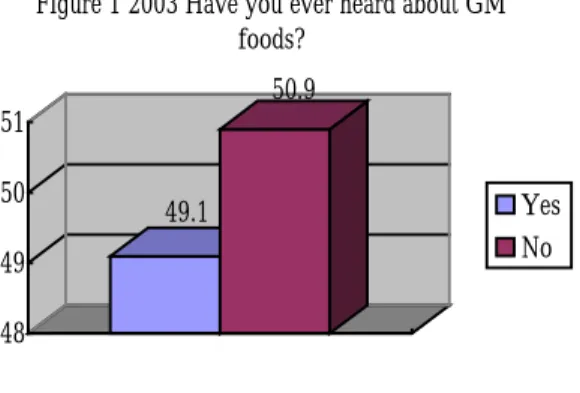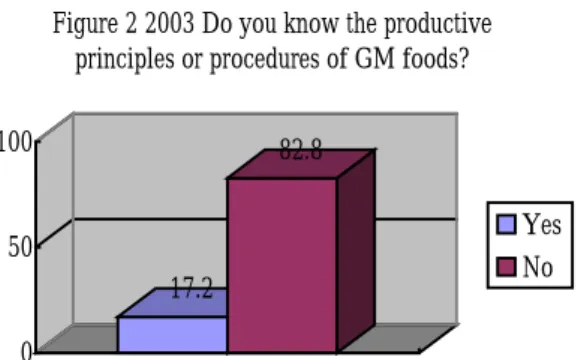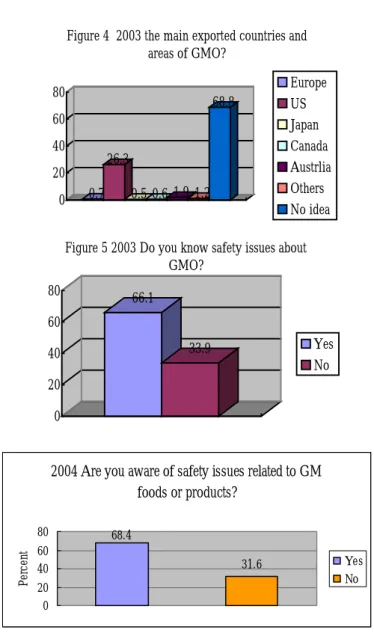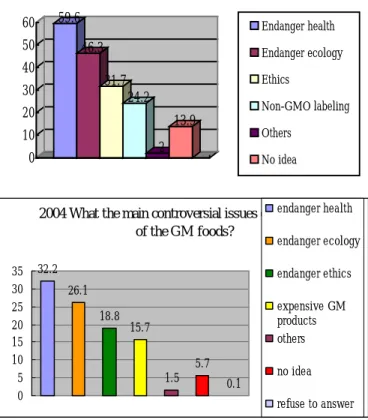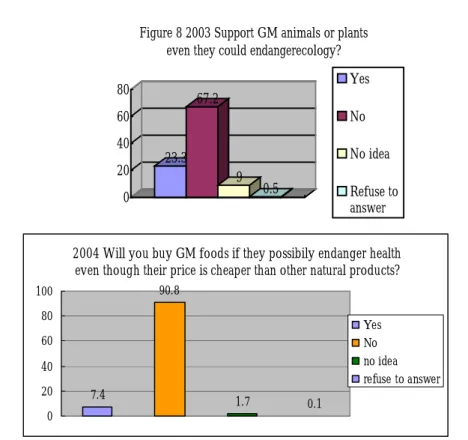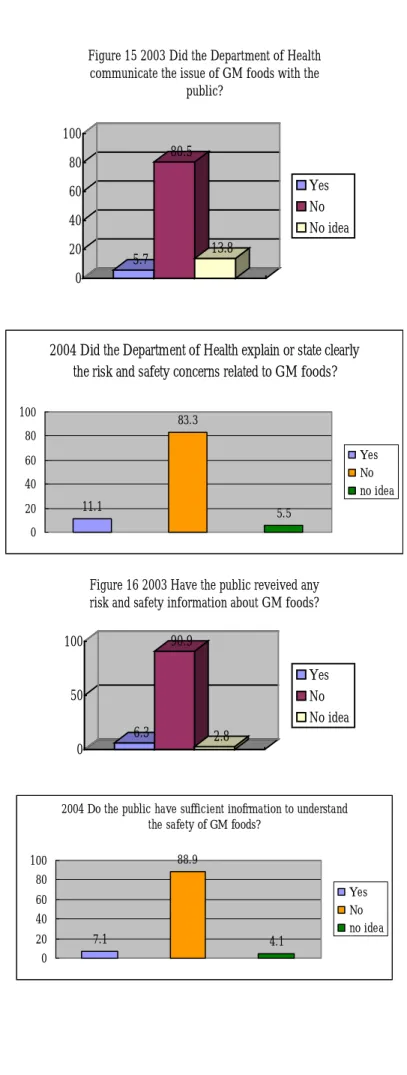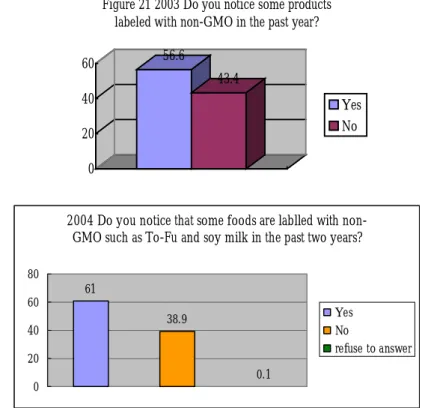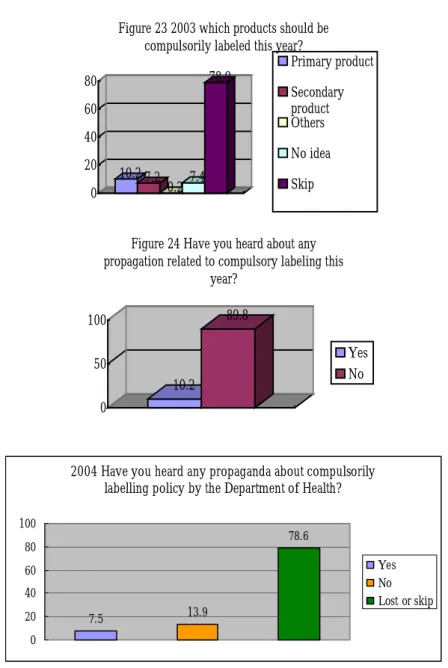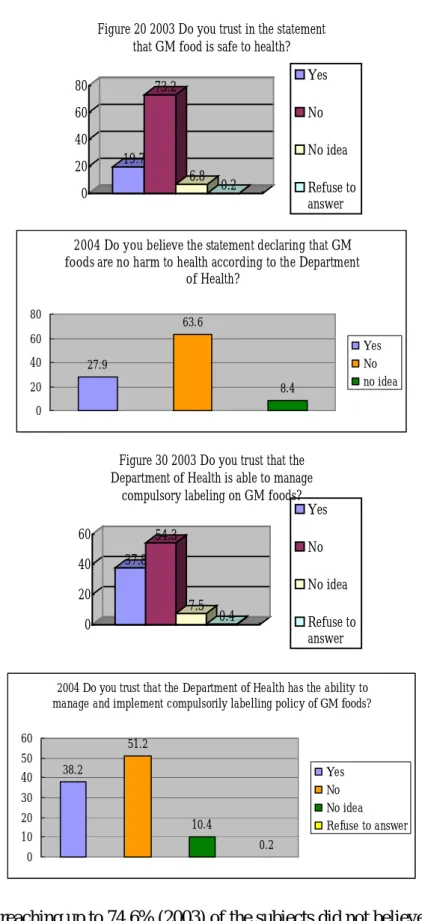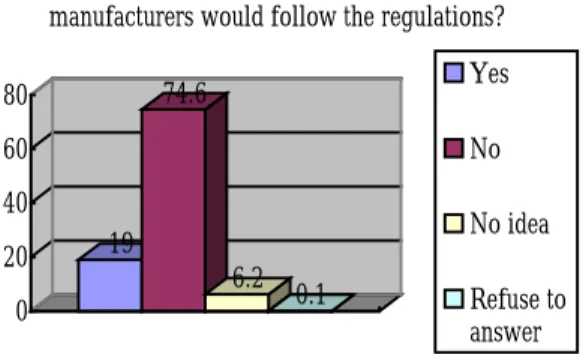行政院國家科學委員會專題研究計畫 成果報告
本土社會之基因科技風險文化整合研究-以基因食品為例
(III)
計畫類別: 個別型計畫 計畫編號: NSC92-3112-H-002-001- 執行期間: 92 年 05 月 01 日至 93 年 07 月 31 日 執行單位: 國立臺灣大學國家發展研究所 計畫主持人: 周桂田 報告類型: 完整報告 處理方式: 本計畫可公開查詢中 華 民 國 93 年 10 月 1 日
Abstract
In light of risk perception and risk communication, this article analyzes the perceptions and interaction relationship between the local public, scientific experts, and the state toward technological risks, e.g. genetically modified organisms (GMO), under the development of global technological competitiveness. This article also points out that “valuing scientific research and neglecting its risk” in a local social system which is continually surrounded with hidden risks would result in combination of mainstream scientific rationality and prominent technological policy resources. A dominant scientific view (system) easily develops and oppresses the opposite opinions from ecological rationality and high discontent of social rationality. As a result, monopoly of scientific rationality and submergence of ecological and social rationality are formed.
This relationship lies in the gap of risk perceptions between the public, the state, and scientific experts: the public highly distrust scientists and specialists; scientists and specialists are dissatisfied with the state for lacking of a risk communication mechanism with the doubt of technological policy being misled or legitimacy of scientific research being deprived; the institutional capacity withers for not actively constructing a risk communication mechanism and social risk assessment. Namely, this article explores how a local social system surrounded with hidden risks devastates trust and accumulates unpredictable technological social consequences.
In order to review and examine the development of high-tech countries and society, this article suggests that a sequence of particular problems in local and less advanced countries should be carefully examined based on an institutional constructed mechanism of risk communication and assessment. Also, active interventions are critical for reshaping the relationship between science, the public, and the nation.
Keywords: trust, technological risk, risk perception, risk communication, risk assessment, scientific expert, technological policy, institutional capacity, delayed high-tech risk society
A Research in Risk Perception, Communication and
Decision-making regarding to Genetically Modified
Foods in Taiwan in 2003/2004
Chou, Kuei-Tien Graduate Institute of National Development, Taiwan University
Perspectives
One research point in this two-year research is to explore a question of social
construction concerning public risk perception of GM foods in Taiwan. The theory is
based on a development process that the contents of public perception, experience,
acceptance or learning of complicatedly development of high-tech products originates
from established social contexts and communication relationships in daily life.
Namely, public risk perception is related to the social constructing process of an
individual in an open social context, which comprises system, communication, and
social learning in a society. As a result, this survey intends to conclude the elements of
the theory mentioned above and design diverse groups of analytical variables
including risk perception, risk information, risk assessment, risk communication, risk
political participation, and risk management. According to these groups of variables,
The meaning of research time lies in continually extending systematic practice
and communication practice of GM foods in local society in recent years. For
example, the principles of voluntary labeling on GM foods began from 2002 in
Taiwan. Also, compulsory labeling on GM foods has begun since 2003. Whether risk
communication and risk perception are generated in the process of systematic practice
is worth exploring. At the same time, the issues of latent social communication and
rationality embedded in delayed high-tech risk society (Chou, 2002) and what risk
perception develops in the practice of the new system (compulsory labeling) should
be further discussed.
In other words, does the delayed and latent risk culture with unilateral
communication in Taiwan regenerate new risk perception and awareness during this
period? Or, does this delayed and latent culture continually generate the original
social logic without any significant change? However, the practice and actions of a
new system and the change of public perception of labeling on daily foods are the
questions the people have to face. Hence, this research tries to explore the contentsof
public risk perception and awareness which is composed of autonomous perspective
and action experience in communication, information, participation, and risk
management policy in the practice of new system. On the one hand, people are slowly
aware or unaware of the change of labeling system. On the other hand, they are
making a risk decision whether to buy GM foods in their private communication,
which is very individualized.
This survey also found out that the public in a local society have developed their
own autonomous perspectives and critique philosophy against risk policy such as
the structure of a latent and delayed risk society. Risk perception constructed based on
this perspective and philosophy shows distrust for society and the government. This
set of action philosophy which is very individualized, diffusive, and immature is
repeatedly constructed in a society to form a collective risk discourse. Furthermore, it
becomes the origin of distrust in complex genetic science/technology. Other
technological and social areas such as SARS and Environmental Impact Assessment
could also be influenced.
Experiential Analysis
In light of the procedures of new labeling system and practice development, this
study preliminarily analyzed public risk perception in recent two years. The telephone
survey was from April 21st to 25th in 2003 and from March 29th to April 8th in 2004. Each contains 1702 valid cases in 2003 and 1572 valid cases in 2004 and interval
errors are 3.5% in 2003 and 3.36% in 2004. The content of questionnaire consists of
risk perception, transparency of risk information, risk communication, the awareness
of risk assessment, risk policy participation, risk management, and trust based on the
theory of risk perception.
1. Delayed and Latent Risk Perception (Figure 1)
49.1
50.9
49 50 51
Figure 1 2003 Have you ever heard about GM foods?
Yes No
2004 Have you ever heard about GM foods? 56.5% 43.5% 0.0% 20.0% 40.0% 60.0% Yes No
The first point explored in the survey is that the information concerning GM
foods is not clear to the public. Only 836 cases (49.1%) in 2003 and 888 cases (56.5%)
in 2004 have ever heard about GM foods, and 866 cases (50.9%) in 2003 and 684
cases (43.5%) in 2004 have never heard about GM foods, which do not include the
failed cases such as the interviewee refusing to answer or breaking off the interview.
More than or near half interviewed people have never heard or been aware of this
disputed issue. This result corresponds and extends the inference from this previous
research, which is that the delayed risk social structure in Taiwan regenerates
unawareness and ignorance of the public. This social context of ignorant risk not only
delays the public response to issues of politics, society, or food safety but also
regenerates latent and hidden risk social structure and contexts.
2. Blurred Risk Awareness
Based on the successful cases that have heard and known about GM foods, their
risk perception and knowledge background can be obtained. High as 82.8% of the
public in 2003 indicated that they do not understand the principles or productive
procedures of GM foods (Figure 2), which shows that this complex high-tech product
17.2
82.8
0 50 100
Figure 2 2003 Do you know the productive principles or procedures of GM foods?
Yes No
communication are obviously insufficient in the whole society, and the access of
learning and perception is none. This result also shows that only 30.5% (2003) and
29.2% (2004) of the subjects know that the daily nutrition, soy bean, is the main
imported GM food in Taiwan (figure 3). Only 26.3% (2003) of the subjects know the
0.8 0.4 1.4 30.5 0.7 66.1 0 20 40 60 80 Figure 3
2003 the main imported GM foods in Taiwan?
Mung Bean Red Bean Oat Soy Bean Black Soy Bean No idea
2004 Which GM food is the top imported merchants in Taiwan? 0.3 7.9 29.2 0.3 1.9 60.4 0.0 50.0 100.0 Mung Bean Corn Soy Beans Black Soy Beans Others
No Ideas
main exporting country (figure 4); however, only 66.1% (2003) and 68.4% (2004) of
0.7 26.3 0.5 0.6 1.9 1.2 68.8 0 20 40 60 80
Figure 4 2003 the main exported countries and areas of GMO? Europe US Japan Canada Austrlia Others No idea 66.1 33.9 0 20 40 60 80
Figure 5 2003 Do you know safety issues about GMO?
Yes No
2004 Are you aware of safety issues related to GM foods or products? 31.6 68.4 0 20 40 60 80 P er cen t Yes No
words, most people who have ever heard or known about GM foods do not
understand the production, imported categories, and productive areas; nevertheless,
two thirds of the public are aware of safety disputes of GM foods. This shows that the
public who is ever involved in this issue have preliminarily developed risk perception,
but the basic details are still blurred. Being further questioned with information
origins, most people (85.8%) answered that the media reports are the major source.
According to the previous research inference and continual observation, the time that
the media in Taiwan discussed the risk of GM foods principally focused on August
and late October in 2000. Follow-up media discourses are scarce because seldom
and communication, local public have long lacked for information and content
learning from media. Information gap and knowledge difference (Chou, 2002) formed
by this still constructively exist.
3. Risk Perception of Subjective Construction
Although constructive knowledge and information gap cause blurred risk
perception, 59.6% (2003) and 23.2% (2004) of the subjects clearly considered that
GMO potentially threatens health; 46.3 (2003) and 26.1% (2004) of the subjects
perceived that GMO potentially endangers ecology; 31.7% (2003) and 18.8% (2004)
of the subjects observed that the people who abide by religious or ethical bans such
as being a vegetarian can be impacted by GMO (figure 6). According to these data,
59.6 46.3 31.7 24.2 2 13.9 0 10 20 30 40 50 60
Figure 6 2003 main disputes of GMO?
Endanger health Endanger ecology Ethics Non-GMO labeling Others No idea
2004 What the main controversial issues do you think of the GM foods? 32.2 26.1 18.8 15.7 1.5 5.7 0.1 5 10 15 20 25 30 35 endanger health endanger ecology endanger ethics expensive GM products others no idea
2004 Do you agree that GM O could possibly endanger or affect ecology?
69.7 18.6 4.5 7.1 0.1 0 10 20 30 40 50 60 70 80 agree not agree hard to judge no idea refuse to answer
2004 Do you agree that GMO could possibly affect people's health? 68.7 17.8 7.2 6.1 0.2 0 20 40 60 80 agree not agree hard to judge no idea refuse to answer
2004 Do you agree that there are many advantages of GMO?
55.2 27.8 8.2 8.8 0 10 20 30 40 50 60 agree not agree hard to judge no idea
2004 Do you believe that GM foods are controllable in the aspects of health and ecology?
35.6 52.3 11.8 0.3 0 10 20 30 40 50 60 believe disblieve no idea refuse to answer
about two thirds of the people do not support the production or
price, 87.5% (2003) and 90.8% (2004) of the subjects still refuse to buy them with
concern for health.
23.3 67.2 9 0.5 0 20 40 60 80
Figure 8 2003 Support GM animals or plants even they could endangerecology?
Yes No No idea Refuse to answer 2004 Will you buy GM foods if they possibily endanger health
even though their price is cheaper than other natural products?
7.4 90.8 1.7 0.1 0 20 40 60 80 100 Yes No no idea refuse to answer
In limited information and blurred risk perception, the public have subjectively
constructed their own risk perception and held refusal attitudes against GM foods. In a
word, people usually unilaterally accept and believe that they control the only
information in a closed society without information exchange and communication.
The messages revealing crises of health, ecology, or ethics become firm but
assumptive belief among people. Then people subjectively construct risk perception
in themselves, which determines their judgment and plants a seed of GMO disputes
4. Risk Assessment Perception and Risk Communication
GM foods contain the essence of risk controversy due to the complexity of high
technology. Hence, the aspects such as ethics and social risk should be further
explored, which is different from traditional risk assessment that only limited in the
topics of healthy and environmental risks. Besides discussion by specialists, two-way
risk communication besides media between the main administration and the public are
also be examined. When a social medium fails to fulfill its role in risk communication,
a two-way, multiple, and diverse risk communication mechanism offering risk
information and bridging public inclinations is obviously essential.
In the investigation, the public have a very strong perception believing that risk
assessment of GM foods is a necessary work respectively on health safety,
environmental ecology safety, religion and ethics, and social purchasing power (figure
11). However, 72.6% (2003) and 61.3% (2004) of the subjects had no idea that GM
97.1
0.7 2.2 0
50 100
Figure11 2003 Should isk and safety assessment be implemented before a product enters the
market?
Yes No No idea
2004 Do you know that risk and safety assessment should be implemented before a GM product enter the market?
38.7 61.3 0 10 20 30 40 50 60 70 Yes No
foods should be assessed and controlled by the Department of Health in Taiwan
before entering the market (figure 12). The question is that 80.5% (2003) and 83.3%
(2004) of the people subjectively considered that the Department of Health does not
27.4
72.6
0 50 100
Figure12 2003 do you know that risk and safety assessment is required before a product enters
the merket?
Yes No
2004 Which aspects of assessment do you think that is necessary to be examined?
8.9 10.7 20.9 26.5 32.3 0.4 0.3 0 0 10 20 30 40 expensive non-GMO products religious ethics scientific safety
environmental and ecological safety
health others no idea refuse to answer
communicate and explain risk assessment of GM foods with the public (figure 15).
Overall, 90.9% (2003) and 88.9% (2004) of the public did not obtain enough
5.7 80.5 13.8 0 20 40 60 80 100
Figure 15 2003 Did the Department of Health communicate the issue of GM foods with the
public?
Yes No No idea
2004 Did the Department of Health explain or state clearly the risk and safety concerns related to GM foods?
11.1 83.3 5.5 0 20 40 60 80 100 Yes No no idea 6.3 90.9 2.8 0 50 100
Figure 16 2003 Have the public reveived any risk and safety information about GM foods?
Yes No No idea
2004 Do the public have sufficient inofrmation to understand the safety of GM foods?
7.1 88.9 4.1 0 20 40 60 80 100 Yes No no idea
2004 Is there any channel that the public can express their concerns about GM foods to the governments?
13.5 59.7 10 16.8 0 20 40 60 80 Yes No civil groups no idea
of local risk communication, risk communication as a significant index between the
government and the public is also absent. Without risk information reported by media
and risk communication between the government and the public, the mechanism
lacking of social learning contains more hidden risks. Thus the differences of risk
perception are caused. These procedures and phenomena indicated the same social
crisis according to the practical experience of compulsory labeling policy in this year.
5. Compulsory Labeling Policy without Risk Communication
This year that the government begins the policy of compulsory labeling on GM
foods is well-timed for policy propagation and risk communication. Compared to the
restricted use policy on plastic bags of which the Environmental Protection
Administration put great efforts on propagation, the Department of Health was
relatively inactive on risk communication. The acts of the Department of Health
happen to corresponding with the critical view of “irresponsible organization” in the
theory of risk society. As a modern bureaucratic organization, the Department of
Health did not actively offer information and communication opportunities for the
Even though 56.6% (2003) and 61% (2004) of the public have gradually noticed
the products with “voluntary labeling” of non GMO (figure 21) on the selves of
supermarkets in the past two years, 2002 and 2003, 78.9% (2003) and 78.6% (2004)
56.6 43.4 0 20 40 60
Figure 21 2003 Do you notice some products labeled with non-GMO in the past year?
Yes No
2004 Do you notice that some foods are lablled with non-GMO such as To-Fu and soy milk in the past two years?
61 38.9 0.1 0 20 40 60 80 Yes No refuse to answer
of the public have no idea that compulsory labeling policy beginning on January 1st, 2004 (figure 22), and more than 85% (2003) of people did not know about what
21.1 78.9 0 20 40 60 80
Figure22 2003 Do you know GM foods should be labeled from this year?
Yes No
2004 Do you know that compulsorily labelling on GM foods begins January 2004? 21.4 78.6 0 20 40 60 80 100 Yes No
kinds of products should be labeled compulsorily (figure 23). 89.8% (2003) and
78.6% (2004) of the interviewees indicated that they had never heard about any
propagation related to compulsory labeling policy which was carried out by the
Department of Health this year (figure 24). In light of two-way risk
10.2 7.2 0.2 7.4 78.9 0 20 40 60 80
Figure 23 2003 which products should be compulsorily labeled this year?
Primary product Secondary product Others No idea Skip 10.2 89.8 0 50 100
Figure 24 Have you heard about any propagation related to compulsory labeling this
year?
Yes No
2004 Have you heard any propaganda about compulsorily labelling policy by the Department of Health?
78.6 40 60 80 100 Yes No Lost or skip
communication, the subjects were questioned respectively according to two
propagation methods, media and other channels, taken by the Department of Health to
fully communicate with the society. The results reveals that 82.7% (2003) of the
interviewees regarded the main administration fails to inform the public the
compulsory labeling policy of GMO (figure 27). Also, 80.6% (2003) of the subjects
said the Department of Health did not regularly announce relative information about
GMO through media.
6.9 82.7 10.4 0 50 100
Figure 27 2003 Did the Department of Health communicate compulsory labeling policy of
GM foods to the society?
Yes No No idea
6. Social Distrust in Hidden Risk Communication
Due to the lack of active risk communication and opportunities and procedures
of two-way social learning, nearly two thirds of the interviewees stated that the
decision-making process of GM foods requires transparency when the Department of
Health administers this affair. In these delayed and latent risk hidden structure and
social developmental contexts, the public do not trust high-tech products more and
more. Nevertheless, trust is the basis of a modern society. The survey in Taiwan
shows that 73.2% (2003) and 63.3% (2004) of the public distrust the statement that
GM foods are completely safe to health made by the Department of Health (figure 20).
Department of Health is able to manage the potential risks of GMO (figure 30). 19.7 73.2 6.8 0.2 0 20 40 60 80
Figure 20 2003 Do you trust in the statement that GM food is safe to health?
Yes No No idea Refuse to answer 2004 Do you believe the statement declaring that GM foods are no harm to health according to the Department
of Health? 27.9 63.6 8.4 0 20 40 60 80 Yes No no idea 37.8 54.3 7.5 0.4 0 20 40 60
Figure 30 2003 Do you trust that the Department of Health is able to manage
compulsory labeling on GM foods? Yes No No idea Refuse to answer
2004 Do you trust that the Department of Health has the ability to manage and implement compulsorily labelling policy of GM foods?
38.2 51.2 10.4 0.2 0 10 20 30 40 50 60 Yes No No idea Refuse to answer
19 74.6 6.2 0.1 0 20 40 60 80
Figure 32 2003 Do you trust that the manufacturers would follow the regulations?
Yes No No idea Refuse to answer
situation of distrust in risk has highly developed. Because risk has not been
collectively discussed for communication and mutual learning, aggregative
recognition and views are not formed in the society and further develop political
pressures. Risk has become the problem of high individualized distrust: distrust in
scientific statements of the main administration and distrust in safety certification of
manufactures. The social basis, trust and recognition, becomes a greater crisis in this
local, delayed, latent, and unknown risk social structure.
7. The Rights of Self-participation and Decision Making of Risk Policy (Figure 17, 18, 19)
Although the recognition crisis of social distrust in a risk hidden social structure
is exposed, the individualized and personalized of risk developmental context does
not impede the development of individual autonomous privileges in a local society
with high exchange of information, especially the perspectives of civil rights to
participate in technological policy decision-making. According to other countries’
experiences, the participation in technological risk policy-making has gradually
As a result, 90.3% (2003) and 67.6% (2004) of the interviewees stated that they
had no opportunities to access the risk policy-making of GM foods (figure 19). It also
corresponds to the fact that the Department of Health had not established any
procedures or mechanism for participation of the public in technological policy
making. This part of issue should be discussed and planned overall under the
framework of technology and society of Taiwan. Also, 86.8% (2003) of the subjects
claimed that the citizens should have the right to participate in decision-making of
technological risk policy (figure 17), which is worth to discuss.
86.8 10.9 2.3 0 50 100
Figure 17 2003 Do the public have the right to participate in decision-making of GM foods
policy?
Yes No No idea
2004 Is there any opportunity that the public participate in the decision-making process? 22.2 67.6 10.2 0 20 40 60 80 Yes No no idea 20.5 65.7 13.9 0 20 40 60 80
figure 18 2003 Do the public have the channel to participate in policy-making of GM foods?
Yes No No idea
9.7
90.3
0 50 100
Figure 19 2003 Do the public have the opportunity to know and participate in
policy-making of GM foods?
Yes No
References:
Chou, Kuei Tien (2002) The theoretical and practical gap of glocalizational risk delayed high-tech risk society, in Taiwan: A Radical Quarterly in Social Studies, No. 45, March 2002, p. 69-122.
Chou, Kuei-Tien (2000) Bio-industry and social risk – delayed high-tech risk society, in Taiwan: A Radical Quarterly in Social Studies, No. 39, September 2000, p. 239-283.
